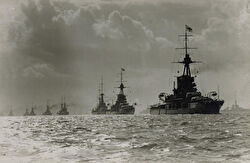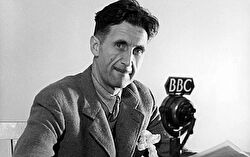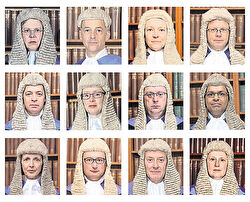
On a sunny day, Marwick Head is a glorious place to be. Sandstone cliffs tumble sheer into peacock and petrol-blue water. And at the top of the headland stands a squat, crenellated tower.
Visible for miles, it has no obvious function — too fat to be a lighthouse, too small to be a castle. A stone panel explains: ‘This tower was raised by the people of Orkney in memory of Field Marshall Earl Kitchener of Khartoum on that corner of his country which he had served so faithfully nearest to the place where he died on duty. He and his staff perished along with the officers and nearly all the men of HMS Hampshire on June 5, 1916.’
Though hardly remembered today, the wreck of the Hampshire was seen at the time as little short of a national disaster. Hundreds of men perished, among them the best-known soldier in the English-speaking world, who became the most senior officer from either side in the First World War to die in active service.
Horatio Herbert Kitchener embodied the British war effort, and his now-forgotten death is a salutary tale about the fate of heroes.
When news of the loss of HMS Hampshire reached London, Sir Arthur Conan Doyle reached for his ink pot. Lord Kitchener, he said, had left behind ‘the memory of something vast and elemental, coming suddenly and going strangely, a mighty spirit leaving great traces of its earthly passage’.
When those shots rang out in Sarajevo in 1914, Britain had been without a war secretary. Kitchener, 64, was a soldier rather than a politician, yet the obvious choice for the job. At 6ft 2in, with piercing blue eyes set in a weathered face, he was an imposing presence. ‘If not a great man, he was, at least, a great poster,’ the prime minister’s wife, Margot Asquith, was supposed to have sneered, referring to the famous recruiting advertisement.
But without his appeal for volunteers Britain could not have survived the early stages of the fighting. He soon became to the First World War what Churchill would later be to the second.
This vain, imposing, arrogant man arrived at the War Office garlanded with medals, stars and satin sashes for raising the Union Jack over numerous corners of foreign fields.
Having survived a brutal upbringing in Ireland (his father disdained blankets, preferring to sleep under sheets of newspaper sewn together, and once punished his son by staking him out on the lawn, wrists and ankles tied to croquet hoops), he had risen to become the greatest public expression of ramrod uprightness.
Kitchener had already served as consul-general in Egypt and commanded the army in India. Most famously, he was ‘the Sudan machine’ — the man who had crushed the massive force of Islamists which had risen in the desert against the British empire.
Even though he had said several times that he would rather sweep the streets than have a job in the War Office, when conflict broke out, Kitchener was immediately appointed war secretary.
The Cabinet table was an odd place for a man who despised politicians. And, by 1916, many of them were coming to despise him, too.
Thousands of British lives had been lost in the doomed Gallipoli adventure, and Kitchener carried the can for a calamitous cock-up in the supply of artillery shells in the spring of 1915. Two years into the war, Prime Minister Herbert Asquith felt able to reduce Kitchener’s responsibilities but dared not cast him completely aside.
But then came an opportunity to get the man out of the way, for a little while at least.
Say what you like about the Kaiser, he was good for Orkney, the windswept, sparsely populated islands north of the Scottish mainland. When the German navy threatened Britain, the Orkneys’ huge, protected bay at Scapa Flow provided a vast natural refuge for much of the Royal Navy’s Grand Fleet.
This was Kitchener’s destination when, on June 4, 1916, he boarded a night train at King’s Cross station for the 700-mile journey north. The following morning he crossed to the Scapa anchorage. Here he boarded the armoured cruiser HMS Hampshire to embark upon a secret voyage to Archangel in northern Russia, for talks with Britain’s Russian allies.
The tsar was begging for fresh supplies of guns and explosives, and Britain was worried whether Russia, which had taken enormous casualties, would have the will to stay the course of the war. Kitchener jumped at the idea of leading a mission of reassurance. As the commander of the Grand Fleet, Admiral John Jellicoe, recalled later, the war secretary ‘expressed delight at getting away for a time from the responsibilities and cares attaching to his Office’.
The captain of the ship carrying the war secretary and his dozen-strong staff had been ordered not to follow the obvious route to Russia. Instead of using the sea lanes regularly patrolled by mine-sweeping vessels, the Hampshire was to hug the western coast of the Orkneys and only head for Russia once it had passed to the north of the islands.

Kitchener boards HMS Iron Duke from HMS Oak at 12.25pm on 5 June 1916 prior to lunching with Admiral Lord Jellicoe at Scapa Flow.
There was certainly a reasonable argument for the unusual course, for a fierce storm was blowing from the north-east and the lee of the islands offered some shelter. Even though the sea was far too rough to launch a torpedo, the Hampshire was instructed to maintain a speed of 18 knots to outrun any U-boats.
That afternoon the storm changed direction and was soon blowing into the face of the warships. Nonetheless, Herbert Savill, the captain of the Hampshire, had soon outpaced the two destroyers assigned as escort vessels. By 7pm he had sent them back to base.
Less than an hour later there was a tremendous explosion. The Hampshire shuddered and took on water.
‘It was as though an express train crashed into us,’ recalled a stoker who survived.
Within minutes, the vessel was sinking by the bows, with most of the lifeboats unlaunchable in the storm. It was still daylight, and in the Orkneys, observers from the Royal Garrison Artillery had seen the Hampshire explode a mile or so off the coast.
The postmistress in the remote settlement of Birsay sent an SOS by telegraph to alert the naval authorities. But the Hampshire went down in 15 minutes — time only to launch three small life rafts, which were soon hopelessly overcrowded.
The local archives hold the recollections of some of the Orcadians who braved the howling winds to try to rescue the sailors. They found the life rafts dashed on the rocks, one thrust by the enormous waves into a crevice in the cliffs high above.
The official report lists 643 dead, though local historian Brian Budge believes the true figure to be 725. What is certain is that there were a mere 12 survivors.
Of Lord Kitchener, there was no sign at all. Though corpses continued to wash up for weeks afterwards, Kitchener’s body was never found.
Two survivors later testified to an Admiralty inquiry that as the ship sank, the British war secretary emerged from the gun room, when there was a call of ‘Make way for Lord Kitchener!’. He was last seen standing in his uniform on the starboard side of the quarterdeck, calmly talking to two staff officers as the ship went down.
The King noted his personal distress at the news of Kitchener’s death in his diary: ‘It is indeed a heavy blow to me & a great loss to the Nation & the Allies.’ He ordered Army officers to wear black armbands for a week. Across the nation, hands trembled as people read of the calamity. The Daily Mirror distributed 1.5 million copies that day.
The conspiracy theories began almost at once. How could such an important figure, in the full protection of the greatest navy in the world, be dead?
On June 7, the Evening News reported that all over London people believed the sinking had been the work of German secret agents. Others even claimed that the disaster had been perpetrated by the British government.
Then there were the theories that Kitchener wasn’t dead at all. His sister had been unable to make contact with him through a medium, so obviously he must be alive! He was in Russia, commanding the tsar’s army. He had been spotted living in a cave in Orkney. Like King Arthur, Kitchener would return when his country most needed him.
The Admiralty conducted two investigations, the first in the immediate aftermath of the disaster, the second ten years later. Each concluded that the ship must have hit a mine.
In July, Sir George Arthur, Kitchener’s secretary, wrote to tell Admiral Jellicoe that the supposedly secret visit to Russia had been common knowledge there long before he had even arrived in Scapa Flow. Had German intelligence intercepted British signals, thereby leading to the mining of the waters off Marwick Head? Should Admiral Jellicoe have insisted that the Hampshire take the unusual course? Why had his staff ignored not one but three intelligence reports of German U-boat activity in the area?
An Admiralty directive after the disaster ordered that if Lord Kitchener’s corpse was to be found ashore, it should be retrieved in secret and put inside a special ‘metal-lined shell’ carried on board a Royal Navy ship. Why? The conspiracy theories refused to die.
Another concerned MP, Edwin Scrymgeour, said that he knew a secret police report was being kept hidden, proving that the Admiralty had botched the rescue operation.
Oscar Wilde’s former lover, the poet Lord Alfred Douglas, claimed a conspiracy which took in Winston Churchill and a worldwide network of Jews. It was also said that the Hampshire had been carrying vast quantities of gold to be given to the Russians.
It was only in the late 1960s that the records of Admiralty investigations — coming to the pedestrian conclusion that the ship had almost certainly struck a mine — were declassified.
Reports from captured German archives note that the log of submarine U75 recorded her scattering mines in the area just before the disaster — the U75 claimed the Hampshire as one of her victims.
Yet when the Kitchener files in the National Archives were reviewed by officials in 1973 and 1981, two were still judged unsuitable for publication and sealed until the end of 2015 and the end of 2025. If there was a conspiracy, it was being hidden from sight for a remarkably long time.
Was there really a cover-up? Or is there something in the death of a hero that makes a conspiracy seem more believable?
Orkney’s folk-memory seems to hold it as fact that local people desperate to rescue sailors had been blocked from doing so, sometimes at the point of a bayonet. There are still Orcadians who believe British military headquarters ordered the local lifeboat not to attempt a rescue. Much of this is nonsense. Yet the bad smell lingers.
Though several notables attended the unveiling of Kitchener’s statue on Horse Guards Parade, not a single senior member of the government came to the dedication of the Orkney memorial.
Admiralty investigations into the sinking concluded there was no conspiracy. They would, wouldn’t they? And what could be so sensitive that two files in the National Archives remained closed to the public until the end of 2015 and 2025? Was it something about his private life?
Kitchener was long ago conscripted into the ranks of homosexual history.
He was accompanied on his final journey by his aide-de-camp, ‘Fitz’ — Captain Oswald Fitzgerald, of the 18th Bengal Lancers — the latest in a series of handsome younger men on his staff. Fitzgerald had saved his boss from a would-be assassin in Cairo and Kitchener had planned to bequeath his 5,000-acre African estate to him.
As it was, ‘they died in each other’s arms when the HMS Hampshire struck a mine off Orkney in 1916’, the gay activist Peter Tatchell informed Guardian readers ten years ago. There is not a shred of evidence to support this claim.
It is true that Kitchener never married. It is certain that Fitzgerald also died when the Hampshire went down, and that he had been with Kitchener for nine years, though that hardly adds up to conclusive evidence.
At the time of Kitchener’s eminence (and, indeed, until 1994), homosexual activity in the Army was a court martial offence. But homosexuals were, and are, almost certainly as well represented in the Army as in any other walk of life.
The occasional remark from enemies that Kitchener’s time in Egypt had enhanced his ‘taste for buggery’ proves nothing. Nor does his near-kleptomaniac enthusiasm for fine porcelain or his passion for orchids, textiles, flower arranging and his pet poodle. Whatever his aesthetic
enthusiasms, there is not a jot of proof that Kitchener was what we would understand to be an active homosexual.
So what could be sufficiently sensitive about this great British hero, and his death, that one government after another deemed the files about him should stay secret so long?
I submitted a Freedom of Information Act request to have the Kitchener files declassified, and discovered that, alas, our heroes succumb to the same plodding fate as the rest of us.
The papers are as dull as ditchwater. The Inland Revenue wants to get its hands on the proceeds of a sale of a few bits of pottery from the estate. There are pages and pages of turgid legalese. But there are no revelations about Kitchener’s private life, no mutters of official anxiety, nothing to suggest a conspiracy of any kind.
The banal is always more likely than the bizarre. With all its strange public displays of grief and crackpot conspiracy theories, the reaction to Kitchener’s disappearance had about it some of the characteristics of the death of Princess Diana.
Kitchener was a hero for a different age: who can even name a single serving general today? But once someone has found a place in the popular imagination, we do not let them go easily.
Courtesy of The Daily Mail. Original article here.



